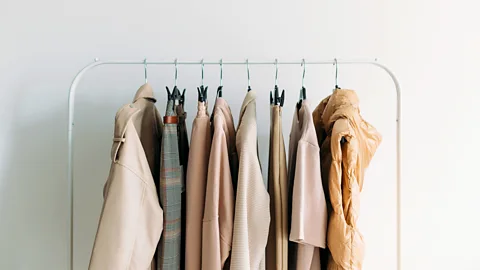 Getty Images
Getty ImagesThe dopamine-spiking effects of ultra-fast fashion are far outweighed by the wellbeing rewards of a capsule wardrobe, according to these less-is-more experts.
In his 1994 book Weniger, Aber Besser, the German industrial designer Dieter Rams famously wrote that “good design is as little as possible. Less, but better, because it concentrates on the essential aspects”. He was referring to the principles of product design, but this theory can just as easily be applied to our wardrobes – especially given that in the decades since Rams’ proclamation, there has been an alarming acceleration in the amount of clothes we buy, and a correlating decline in quality and durability. Every year, somewhere between 80 billion and 150 billion new items of clothing are produced globally, while individually we now purchase five times as many clothes as we did in the 1980s, often wearing items some seven to 10 times before discarding them (a 36% decrease from 15 years ago).
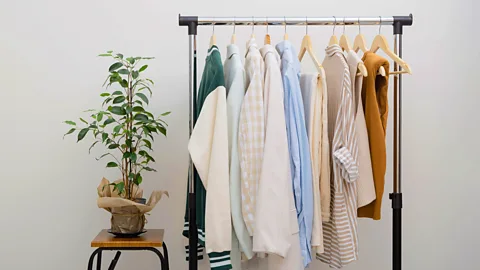 Alamy
AlamyThis is largely down to the proliferation of cleverly targeted online advertisements, an ever-shifting trend cycle propelled by social media, and the burgeoning ultra-fast-fashion market which encourages buyers to purchase more for less, and reap the short-lived, dopamine-spiking rewards. That said, there’s no denying that clothes have the power to make us feel good.
“A lot of fashion is about newness,” Tiffanie Darke, a fashion writer and sustainability strategist, tells the BBC. “We as creatures are always trying to move forward and renew ourselves – whether that’s a new season, a new year’s resolution or a new job. We want to progress ourselves personally, and clothes form a really important part of that.” And Darke, who is also interim CEO of Smartworks – a charity that provides advice and donated clothing to women for employment interviews – has found that this can still be achieved with a “less is more” mentality. It is an approach that not only benefits the planet but also – according to a review by The Journal of Positive Psychology titled Minimalism, Voluntary Simplicity and Wellbeing – our own mental health. In November 2022, a report published by The Hot or Cool Institute revealed that in order for the fashion industry to meet the global target of limiting warming to 1.5C by 2030, British consumers must commit to buying no more than five new items of clothing a year.
Shocked by this statistic, Darke set up the now-viral Rule of Five campaign, inviting others to join her on her mission to buy just five new pieces annually (excluding socks and underwear), as well as four second-hand purchases. “Interestingly, even though I launched the campaign for climate reasons, by far the most overwhelming response from the people who opted to join me was that they were really sick of buying so much. People feel like their shopping has spun out of control: they’re being manipulated to buy more and more, which ultimately leaves you feeling empty and bereft.”
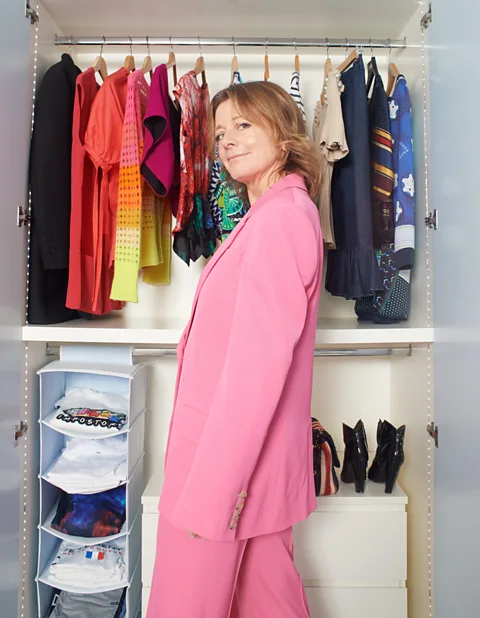 Broadleaf Books
Broadleaf BooksIn September of this year, Darke published What To Wear and Why, a book that offers stomach-churning insight into the damage that shopping addiction is wreaking on the planet, as well as how to compile a mindful, perennially stylish collection of clothes that will free you from the binds of fashion consumerism for good – all gleaned from her own experiences while adhering to the Rule of Five.
The first step, she says, is establishing a capsule wardrobe – a curation of foundational pieces that are not only functional and designed to last but also fit you impeccably and ensure you feel your best. A proponent of what she calls the 80/20 rule (wherein 80% of your wardrobe is made up of “useful, basic classics” and the other 20% more expressive “personality pieces”), Darke’s wardrobe revolves around 10 key items, ranging from a white cotton shirt and a smart jacket to a pair of comfy trousers and a playful knit.
“My capsule wardrobe has been a really useful guideline,” she says. “Of course, it’s different for everybody depending on your circumstances, your work, what climate you live in… but they say you’re only actually wearing 10 or 20 items on a loop at any given time, according to the time of year. So a good starting point is to look at the things you wear all the time, which are usually super functional, and you’ll soon figure out your own list.” Most of her ten new purchases over the past two years have been capsule items, she explains, as well as a pair of decidedly non-sensible gold trousers and a “totally see-through” black crochet skirt.
‘The wardrobe edit‘
Another helpful handbook when it comes to conscientious shopping is How to Wear Everything, the new publication from Kay Barron, the fashion director of Net-a-Porter and Mr Porter. Featuring contributions from some of fashion’s biggest names including Sarah Jessica Parker (talking shoes, no less), stylist Law Roach (responsible for Zendaya’s most iconic outfits) and Jodie Turner Smith (a doyenne of colourful dressing), the book guides readers through the process of creating the perfect wardrobe, from the frequently dreaded task of finding the right jeans to understanding your personal style, plus tips on second-hand shopping, dressing for special occasions and more.
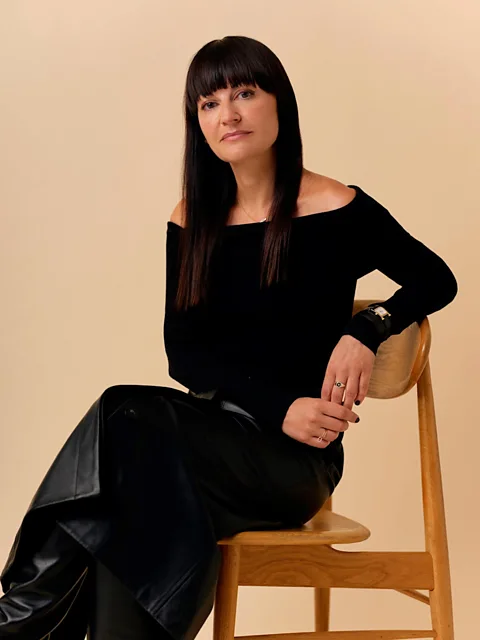 Tom O’Neill
Tom O’NeillFor Barron, the best place to start is by performing what she has dubbed “the wardrobe edit” – a task she says must be undertaken “in a good mood, with lots of time and patience”. “You pull everything out of your wardrobe and try it on,” she tells the BBC. “Then, once you’ve put together outfits made up of the things you like wearing, you can see what’s missing.” She suggests making a list of these “missing” items on your phone, and using this to inform your future purchases. Indeed, one of Barron’s top tips is forward-planning: “If you can afford to, it’s better to buy something you love in that moment rather than shopping in a panic when you have a deadline like a holiday or a wedding. That’s like shopping for food when you’re hungover and hungry; it ends in really bad decisions and spending way more money!”
The wardrobe edit has more than one purpose: it also allows you to “shop” among your existing purchases. “When you rediscover something amazing that you already own, it’s the best feeling in the world,” Barron enthuses, adding that because trend cycles circle around so fast, it’s a good idea to hold on to things like denim “because low-slung boyfriend jeans and skinny jeans inevitably come back into fashion”.
Tips for creating a capsule wardrobe:
• ‘Shop’ among your existing wardrobe
• Balance useful basics with ‘personality pieces’
• Rental is a good way to experiment with looks
Darke also looks to her pre-existing wardrobe for fresh ideas. “You only wear 30% of what you own, and even now I’m only wearing 50 or 60% of that,” she says. “The Rule of Five inspires you to become much more creative and resourceful. You suddenly realise there are old dresses you haven’t worn for ages that you could turn into something else.” She notes, too, the new friendships she’s forged since beginning the campaign, from the seamstress who helps her with alterations to the team at Save Your Wardrobe who assist with everything from mending moth holes to giving old pieces new life.
Rental businesses like By Rotation and My Wardrobe HQ are also an option that both experts advocate for, not only for one-off events but also as a means of experimenting. “On social media, we’re inundated with different people’s styles – it’s new, new, new all the time, and it’s so easy to drown in it, to question what your own style is,” says Barron. “Rental is a great, non-committal way to try something.” She also recommends starting small as a way of having fun and testing the waters for a new look, citing her new pair of “Kermit the Frog” heels in a lime green she says she “would never wear next to my skin or face”.
Barron and Darke aren’t the only industry stalwarts currently campaigning for meaningful change without sacrificing the joy that clothing can spark. This year, the designer and Great British Sewing Bee judge Patrick Grant released Less: Stop Buying So Much Rubbish, a book exploring the rise of mass consumerism and the ways in which “having fewer, better things can make us happier”. And The Enoughness, an engaging new podcast by fashion editor Melanie Rickey, sees guests describe what “just right” (a reference to the Goldilocks Principle) looks like for them, and how achieving that balance has improved their lives.
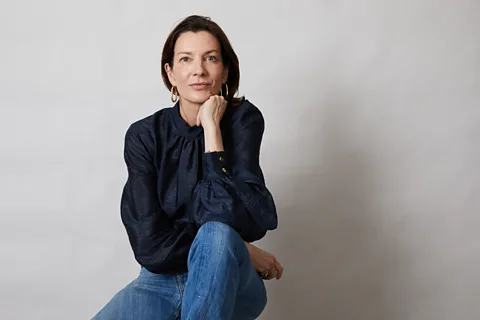 The Enoughness
The EnoughnessRickey’s interviewees have so far included chef Yotam Ottelenghi, expounding upon his tiny kitchen arsenal, and sustainable fashion pioneers Aja Barber and Brett Staniland, who reveal their own methodologies when it comes to embracing a less-is-more wardrobe. “The show’s aim is to gradually shift our mindset to buying less, but better, [and to experience that] as an exciting pursuit, a game with only positive consequences,” Rickey tells the BBC. “Stopping the endless wanting has an incredibly positive effect on every other aspect of life.” The main upshot, she notes, is that you make better decisions and feel better about making them. “Doing esteemable things builds self-esteem,” she says, “and less stuff makes room for more money, more time for experiencing life, and more playtime with what you already have.”
Darke wholeheartedly agrees. “You can’t sell anything on the fact that it’s sustainable alone – we live in a society where nobody wants to live with less. It’s about looking at what you’ll gain from this approach, aside from its positive impact on the planet. And what I would say is that a) you’ll save a ton of money and b) it’s a really interesting exercise in self-knowledge. Being limited with your options forces you to think about who you are as you move through the world, and what you want to look like as you do, and that is really empowering.”









